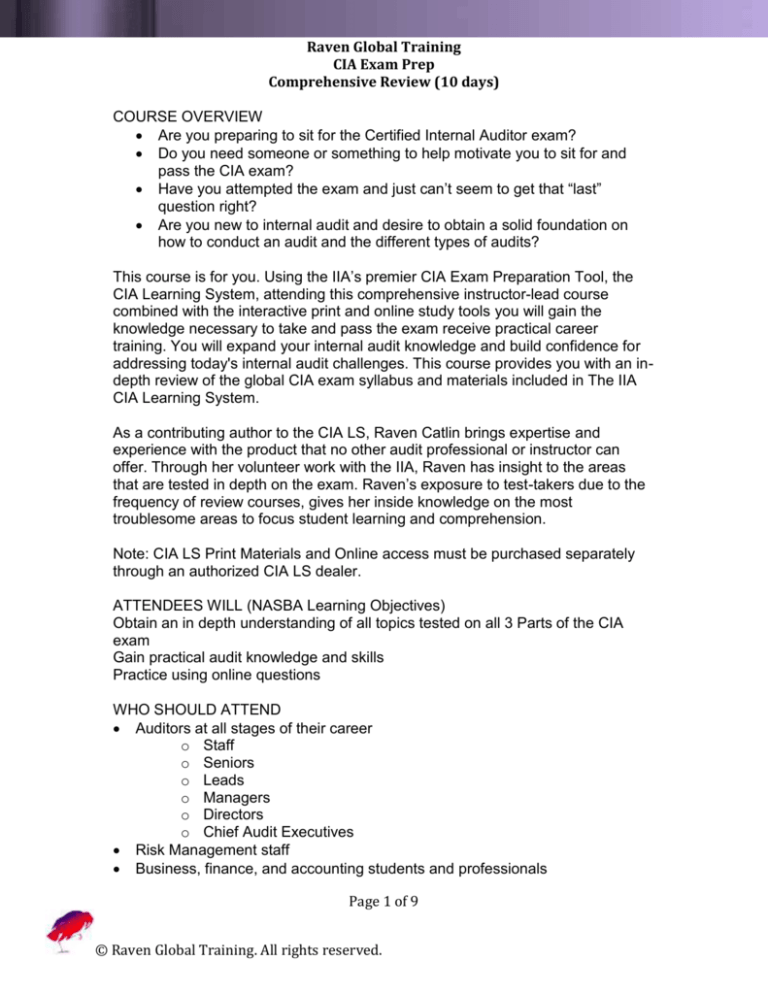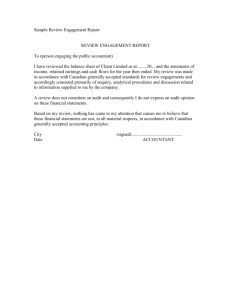
Raven Global Training
CIA Exam Prep
Comprehensive Review (10 days)
COURSE OVERVIEW
Are you preparing to sit for the Certified Internal Auditor exam?
Do you need someone or something to help motivate you to sit for and
pass the CIA exam?
Have you attempted the exam and just can’t seem to get that “last”
question right?
Are you new to internal audit and desire to obtain a solid foundation on
how to conduct an audit and the different types of audits?
This course is for you. Using the IIA’s premier CIA Exam Preparation Tool, the
CIA Learning System, attending this comprehensive instructor-lead course
combined with the interactive print and online study tools you will gain the
knowledge necessary to take and pass the exam receive practical career
training. You will expand your internal audit knowledge and build confidence for
addressing today's internal audit challenges. This course provides you with an indepth review of the global CIA exam syllabus and materials included in The IIA
CIA Learning System.
As a contributing author to the CIA LS, Raven Catlin brings expertise and
experience with the product that no other audit professional or instructor can
offer. Through her volunteer work with the IIA, Raven has insight to the areas
that are tested in depth on the exam. Raven’s exposure to test-takers due to the
frequency of review courses, gives her inside knowledge on the most
troublesome areas to focus student learning and comprehension.
Note: CIA LS Print Materials and Online access must be purchased separately
through an authorized CIA LS dealer.
ATTENDEES WILL (NASBA Learning Objectives)
Obtain an in depth understanding of all topics tested on all 3 Parts of the CIA
exam
Gain practical audit knowledge and skills
Practice using online questions
WHO SHOULD ATTEND
Auditors at all stages of their career
o Staff
o Seniors
o Leads
o Managers
o Directors
o Chief Audit Executives
Risk Management staff
Business, finance, and accounting students and professionals
Page 1 of 9
© Raven Global Training. All rights reserved.
Raven Global Training
CIA Exam Prep
Comprehensive Review (10 days)
COURSE OUTLINE (80 CPE)
Introduction (1/2 day)
CIA Certification Handbook
CIA application / testing process
CIA Exam Overview
CIA Exam Content Review
Test Taking Tips, Tricks, Strategies, and Practice
o Changing your thinking
o Secrets to the learning process
o The facts of life
o Testing techniques
o Strategies for using your chosen review materials effectively
Creating your study plan
Part 1 (2.5 days)
I. Mandatory Guidance (35-45%)
A. Definition of Internal Auditing
o Define purpose, authority, and responsibility of the internal audit
activity
B. Code of Ethics
o Abide by and promote compliance with The IIA Code of Ethics
C. International Standards
o Comply with The IIA's Attribute Standards
Determine if the purpose, authority, and responsibility of the
internal audit activity are documented in audit charter,
approved by the Board and communicated to the
engagement clients
Demonstrate an understanding of the purpose, authority,
and responsibility of the internal audit activity
o Maintain independence and objectivity
Foster independence
1. Understand organizational independence
2. Recognize the importance of organizational
independence
3. Determine if the internal audit activity is properly aligned
to achieve organizational independence
Foster objectivity
1. Establish policies to promote objectivity
2. Assess individual objectivity
3. Maintain individual objectivity
4. Recognize and mitigate impairments to independence
and objectivity
o Determine if the required knowledge, skills, and competencies are
available
Page 2 of 9
© Raven Global Training. All rights reserved.
Raven Global Training
CIA Exam Prep
Comprehensive Review (10 days)
Understand the knowledge, skills, and competencies that an
internal auditor needs to possess
Identify the knowledge, skills, and competencies required to
fulfill the responsibilities of the internal audit activity
o Develop and/or procure necessary knowledge, skills and
competencies collectively required by the internal audit activity
o Exercise due professional care
o Promote continuing professional development
Develop and implement a plan for continuing professional
development for internal audit staff
Enhance individual competency through continuing
professional development
o Promote quality assurance and improvement of the internal audit
activity
Monitor the effectiveness of the quality assurance and
improvement program
Report the results of the quality assurance and improvement
program to the board or other governing body
Conduct quality assurance procedures and recommend
improvements to the performance of the internal audit
activity
II. Internal Control / Risk (25-35%) – Awareness Level (A)
A. Types of Controls (e.g., preventive, detective, input, output, etc.)
B. Management Control Techniques
C. Internal Control Framework Characteristics and Use (e.g., COSO,
Cadbury)
o Develop and implement an organization-wide risk and control
framework
D. Alternative Control Frameworks
E. Risk Vocabulary and Concepts
F. Fraud Risk Awareness
o Types of fraud
o Fraud red flags
III. Conducting Internal Audit Engagements – Audit Tools and Techniques (2838%)
A. Data Gathering (Collect and analyze data on proposed engagements):
o Review previous audit reports and other relevant documentation as
part of a preliminary survey of the engagement area
o Develop checklists/internal control questionnaires as part of a
preliminary survey of the engagement area
o Conduct interviews as part of a preliminary survey of the
engagement area
o Use observation to gather data
o Conduct engagement to assure identification of key risks and
controls
Page 3 of 9
© Raven Global Training. All rights reserved.
Raven Global Training
CIA Exam Prep
Comprehensive Review (10 days)
o Sampling (non-statistical [judgmental] sampling method, statistical
sampling, discovery sampling, and statistical analyses techniques)
B. Data Analysis and Interpretation:
o Use computerized audit tools and techniques (e.g., data mining and
extraction, continuous monitoring, automated work papers,
embedded audit modules)
o Conduct spreadsheet analysis
o Use analytical review techniques (e.g., ratio estimation, variance
analysis, budget vs. actual, trend analysis, other reasonableness
tests)
o Conduct benchmarking
o Draw conclusions
C. Data Reporting
o Report test results to auditor in charge
o Develop preliminary conclusions regarding controls
D. Documentation / Work Papers
o Develop work papers
E. Process Mapping, Including Flowcharting
F. Evaluate Relevance, Sufficiency, and Competence of Evidence
o Identify potential sources of evidence
Part 2 (2 days)
I. Managing the Internal Audit Function (40-50%)
A. Strategic Role of Internal Audit
o Initiate, manage, be a change catalyst, and cope with change
o Build and maintain networking with other organization executives
and the audit committee
o Organize and lead a team in mapping, analysis, and business
process improvement
o Assess and foster the ethical climate of the board and management
Investigate and recommend resolution for ethics/compliance
complaints, and determine disposition of ethics violations
Maintain and administer business conduct policy (e.g.,
conflict of interest), and report on compliance
o Educate senior management and the board on best practices in
governance, risk management, control, and compliance
o Communicate internal audit key performance indicators to senior
management and the board on a regular basis
o Coordinate IA efforts with external auditor, regulatory oversight
bodies and other internal assurance functions
o Assess the adequacy of the performance measurement system,
achievement of corporate objective – Awareness Level (A)
B. Operational Role of IA
o Formulate policies and procedures for the planning, organizing,
directing, and monitoring of internal audit operations
Page 4 of 9
© Raven Global Training. All rights reserved.
Raven Global Training
CIA Exam Prep
Comprehensive Review (10 days)
o Review the role of the internal audit function within the risk
management framework
o Direct administrative activities (e.g., budgeting, human resources)
of the internal audit department
o Interview candidates for internal audit positions
o Report on the effectiveness of corporate risk management
processes to senior management and the board
o Report on the effectiveness of the internal control and risk
management frameworks
o Maintain effective Quality Assurance Improvement Program
C. Establish Risk-Based IA Plan
o Use market, product, and industry knowledge to identify new
internal audit engagement opportunities
o Use a risk framework to identify sources of potential engagements
(e.g., audit universe, audit cycle requirements, management
requests, regulatory mandates)
o Establish a framework for assessing risk
o Rank and validate risk priorities to prioritize engagements in the
audit plan
o Identify internal audit resource requirements for annual IA plan
o Communicate areas of significant risk and obtain approval from the
board for the annual engagement plan
o Types of engagements
Conduct assurance engagements
Compliance audit engagements
Consulting engagements
II. Managing Individual Engagements (40-50%)
A. Plan Engagements
o Establish engagement objectives/criteria and finalize the scope of
the engagement
o Plan engagement to assure identification of key risks and controls
o Complete a detailed risk assessment of each audit area (prioritize
or evaluate risk/control factors)
o Determine engagement procedures and prepare engagement work
program
o Determine the level of staff and resources needed for the
engagement
o Construct audit staff schedule for effective use of time
B. Supervise Engagement
o Direct / supervise individual engagements
o Nurture instrumental relations, build bonds, and work with others
toward shared goals
o Coordinate work assignments among audit team members when
serving as the auditor-in-charge of a project
o Review work papers
Page 5 of 9
© Raven Global Training. All rights reserved.
Raven Global Training
CIA Exam Prep
Comprehensive Review (10 days)
o Conduct exit conference
o Complete performance appraisals of engagement staff
C. Communicate Engagement Results
o Initiate preliminary communication with engagement clients
o Communicate interim progress
o Develop recommendations when appropriate
o Prepare report or other communication
o Approve engagement report
o Determine distribution of the report
o Obtain management response to the report
o Report outcomes to appropriate parties
D. Monitor Engagement Outcomes
o Identify appropriate method to monitor engagement outcomes
o Monitor engagement outcomes and conduct appropriate follow-up
by the internal audit activity
o Conduct follow-up and report on management's response to
internal audit recommendations
o Report significant audit issues to senior management and the board
periodically
III. Fraud Risks and Controls (5-15%)
A. Consider the potential for fraud risks and identify common types of
fraud associated with the engagement area during the engagement
planning process
B. Determine if fraud risks require special consideration when conducting
an engagement
C. Determine if any suspected fraud merits investigation
D. Complete a process review to improve controls to prevent fraud and
recommend changes
E. Employ audit tests to detect fraud
F. Support a culture of fraud awareness, and encourage the reporting of
improprieties
G. Interrogation/investigative techniques – Awareness Level (A)
H. Forensic auditing – Awareness Level (A)
Part 3 (5 days)
I. Governance / Business Ethics (5-15%)
A. Corporate/Organizational Governance Principles – (P)
B. Environmental and Social Safeguards
C. Corporate Social Responsibility
II. Risk Management (10-20%)- Proficiency Level (P)
A. Risk Management Techniques
B. Organizational Use of Risk Frameworks
III. Organizational Structure/Business Processes and Risks (15-25%)
A. Risk/Control Implications of Different Organizational Structures
B. Structure (e.g., centralized/decentralized)
Page 6 of 9
© Raven Global Training. All rights reserved.
Raven Global Training
CIA Exam Prep
Comprehensive Review (10 days)
C. Typical Schemes in Various Business Cycles (e.g., procurement, sales,
knowledge, supply-chain management)
D. Business Process Analysis (e.g., workflow analysis and bottleneck
management, theory of constraints)
E. Inventory Management Techniques and Concepts
F. Electronic Funds Transfer (EFT)/Electronic Data Interchange (EDI)/Ecommerce
G. Business Development Life Cycles
H. The International Organization for Standardization (ISO) Framework
I. Outsourcing Business Processes
IV. Communication (5-10%)
A. Communication (e.g., the process, organizational dynamics, impact of
computerization)
B. Stakeholder Relationships
V. Management / Leadership Principles (10-20%)
A. Strategic Management
o Global analytical techniques
Structural analysis of industries
Competitive strategies (e.g., Porter's model)
Competitive analysis
Market signals
Industry evolution
o Industry environments
Competitive strategies related to:
1. Fragmented industries
2. Emerging industries
3. Declining industries
Competition in global industries
1. Sources/impediments
2. Evolution of global markets
3. Strategic alternatives
4. Trends affecting competition
o Strategic decisions
Analysis of integration strategies
Capacity expansion
Entry into new businesses
o Forecasting
o Quality management (e.g., TQM, Six Sigma)
o Decision analysis
B. Organizational Behavior
o Organizational theory (structures and configurations)
o Organizational behavior (e.g., motivation, impact of job design,
rewards, schedules)
o Group dynamics (e.g., traits, development stages, organizational
politics, effectiveness)
Page 7 of 9
© Raven Global Training. All rights reserved.
Raven Global Training
CIA Exam Prep
Comprehensive Review (10 days)
o Knowledge of human resource processes (e.g., individual
performance management, supervision, personnel
sourcing/staffing, staff development)
o Risk/control implications of different leadership styles
o Performance (productivity, effectiveness, etc.)
C. Management Skills/Leadership Styles
o Lead, inspire, mentor, and guide people, building organizational
commitment and entrepreneurial orientation
o Create group synergy in pursuing collective goals
o Team-building and assessing team performance
D. Conflict Management
o Conflict resolution (e.g., competitive, cooperative, and compromise)
o Negotiation skills
o Conflict management
o Added-value negotiating
E. Project Management / Change Management
o Change management
o Project management techniques
VI. IT / Business Continuity (15-25%)
A. Security
Physical/system security (e.g., firewalls, access control)
Information protection (e.g., viruses, privacy)
Application authentication
Encryption
B. Application Development
End-user computing
Change control (Proficiency Level)
Systems development methodology (Proficiency Level)
Application development (Proficiency Level)
Information systems development
C. System Infrastructure
Workstations
Databases
IT control frameworks (e.g., eSAC, COBIT)
Functional areas of IT operations (e.g., data center
operations)
Enterprise-wide resource planning (ERP) software (e.g.,
SAP R/3)
Data, voice, and network communications/connections (e.g.,
LAN, VAN, and WAN)
Server
Software licensing
Mainframe
Operating systems
Web infrastructure
Page 8 of 9
© Raven Global Training. All rights reserved.
Raven Global Training
CIA Exam Prep
Comprehensive Review (10 days)
D. Business Continuity
IT contingency planning
VII. Financial Management (13-23%)
A. Financial Accounting and Finance
Basic concepts and underlying principles of financial
accounting (e.g., statements, terminology, relationships)
Intermediate concepts of financial accounting (e.g., bonds,
leases, pensions, intangible assets, RandD)
Advanced concepts of financial accounting (e.g.,
consolidation, partnerships, foreign currency transactions)
Financial statement analysis (e.g., ratios)
Types of debt and equity
Financial instruments (e.g., derivatives)
Cash management (e.g., treasury functions)
Valuation models
Business valuation
Inventory valuation
Capital budgeting (e.g., cost of capital evaluation)
Taxation schemes (e.g., tax shelters, VAT)
B. Managerial Accounting
General concepts
Costing systems (e.g., activity-based, standard)
Cost concepts (e.g., absorption, variable, fixed)
Relevant cost
Cost-volume-profit analysis
Transfer pricing
Responsibility accounting
Operating budget
VIII. Global Business Environment (0-10%)
A. Economic / Financial Environments
o Global, multinational, international, and multi-local compared and
contrasted
o Requirements for entering the global marketplace
o Creating organizational adaptability
o Managing training and development
B. Cultural / Political Environments
Balancing global requirements and local imperatives
Global mindsets (personal characteristics/competencies)
Sources and methods for managing complexities and
contradictions.
Managing multicultural teams
C. Legal and Economics — General Concepts (e.g., contracts)
D. Impact of Government Legislation and Regulation on Business (e.g.,
trade legislation)
Page 9 of 9
© Raven Global Training. All rights reserved.








